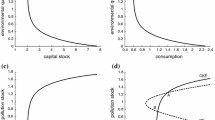Abstract
We study the environmental and economic effects of public abatement in the presence of multiple stable steady-state ecological equilibria featuring reversible hysteresis. The isocline for the stock of pollution possesses two stable branches. Assuming that the ecology is initially located on the upper (high pollution) branch of the isocline, a simple time-invariant temporary abatement policy can be used to steer the environment from the high- to the low-pollution equilibrium. In all models considered in this paper, a “cold turkey” abatement policy is optimal within the class of stepwise policies, i.e. the largest feasible shock should be administered for the shortest possible amount of time. The cold-turkey result is robust to alternative models for the economic system, although there is a capital feedback effect that either helps or hinders the speed of transition to the low-pollution equilibrium.
Similar content being viewed by others
References
Arrow KJ, Bolin B, Costanza R, Dasgupta P, Folke C, Holling C, Jansson B-O, Levin S, Mäler K-G, Perrings C, Pimentel D (1995) Economic growth, carrying capacity, and the environment. Science 268: 520–521
Biggs R, Carpenter SR, Brock WA (2009) Turning back from the brink: detecting an impending regime shift in time to avert it. Proc Natl Acad Sci 106: 826–831
Blanchard O-J (1985) Debts, deficits, and finite horizons. J Polit Econ 93: 223–247
Bovenberg AL, Heijdra BJ (1998) Environmental tax policy and intergenerational distribution. J Public Econ 67: 1–24
Bovenberg AL, Heijdra BJ (2002) Environmental abatement and intergenerational distribution. Environ Resour Econ 23: 45–84
Brock WA, Starrett D (2003) Managing systems with non-convex positive feedback. Environ Resour Econ 26: 575–602
Crépin A-S (2003) Multiple species boreal forests: what Faustmann missed. Environ Resour Econ 26: 625–646
Crépin A-S (2007) Using fast and slow processes to manage resources with thresholds. Environ Resour Econ 36: 191–213
Heijdra BJ (2009) Foundations of modern macroeconomics. 2edn. Oxford University Press, Oxford
Heijdra BJ, Heijnen P (2012) Environmental abatement policy and the macroeconomy in the presence of ecological thesholds: mathematical appendix. Faculty of Economics and Business, University of Groningen, July
Heijnen P, Wagener F (2009) Managing the environment and the economy in the presence of hysteresis and irreversibility. Mimeo, CeNDEF, University of Amsterdam (March)
Janssen MA, Anderies JM, Walker BH (2004) Robust strategies for managing rangelands with multiple stable attractors. J Environ Econ Manag 47: 140–162
Levin SA, Pacala SW (2003) Ecosystem dynamics. In: Mäler K-G, Vincent JR (eds) Handbook of environmental economics. North-Holland, Amsterdam
Mäler K-G, Li C-Z (2010) Measuring sustainability under regime shift uncertainty: a resilience pricing approach. Environ Dev Econ 15: 707–719
Mäler K-G, Xepapadeas A, de Zeeuw A (2003) The economics of shallow lakes. Environ Resour Econ 26: 603–624
Muradian R (2001) Ecological thresholds: a survey. Ecol Econ 38: 7–24
Prieur F (2009) The environmental Kuznets curve in a world of irreversibility. Econ Theory 40: 57–90
Ranjan R, Shortle J (2007) The environmental Kutnets curve when the environment exhibits hysteresis. Ecol Econ 64: 204–215
Scheffer M, Carpenter S, Foley JA, Folke C, Walker B (2001) Catastrophic shifts in ecosystems. Nature 413: 591–596
Wagener F (2009) Shallow lake economics run deep. Discussion paper TI 2009-033/1, Tinbergen Institute
Wirl F (2004) Sustainable growth, renewable resources and pollution: thresholds and cycles. J Econ Dyn Control 28: 1149–1157
Xepapadeas A (2005) Economic growth and the environment. In: Mäler K-G, Vincent JR (eds) Handbook of environmental economics. North-Holland, Amsterdam
Yaari ME (1965) Uncertain lifetime, life insurance, and the theory of the consumer. Rev Econ Stud 32: 137–150
Author information
Authors and Affiliations
Corresponding author
Electronic Supplementary Material
The Below is the Electronic Supplementary Material.
Rights and permissions
About this article
Cite this article
Heijdra, B.J., Heijnen, P. Environmental Abatement and the Macroeconomy in the Presence of Ecological Thresholds. Environ Resource Econ 55, 47–70 (2013). https://doi.org/10.1007/s10640-012-9613-z
Accepted:
Published:
Issue Date:
DOI: https://doi.org/10.1007/s10640-012-9613-z




